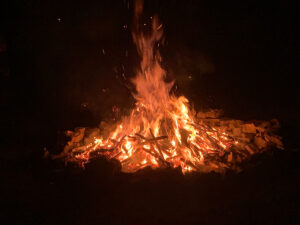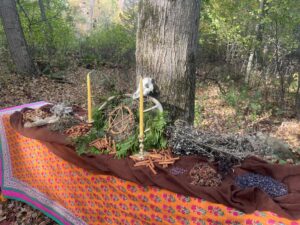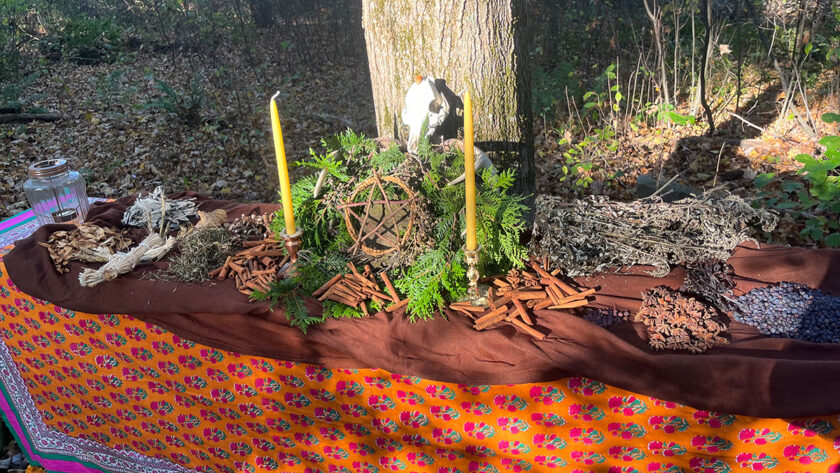Samhain is marked on my landscape by a hard frost–usually occurring in the last two weeks of October. As I wrote about last week, we had our first freeze just this past week and it is the most profound shift of the year. This week, we are looking at more below-freezing temperatures. A green lush landscape gives way to one bathed in browns, oranges, and reds–particularly in the garden, where the hard frost or first freeze indicates a finality to many annual garden crops like eggplant, tomatoes, or squash, with only those hardy plants tucked under cover still surviving. Thus, as the frosts of Samhain clear away the old to make way for rest and later, renewal in the spring, it is a good time to do this same kind of work within ourselves.
In an earlier Samhain post exploring themes for the wheel of the year in the age of the Anthropocene, I focused on the theme of “release” for this time of year. This post returns to that theme with a specific ritual and set of practices for releasing that which no longer serves you with the power of sacred herbs. I was recently able to share a group version of this ritual with some of my friends in our local eclectic women’s circle and it was a very powerful experience. So let’s talk about one form of releasing today and I’ll share some information on the shadow work and self-work that makes this a powerfully transformative experience.
Releasing and Jung’s Individuation

Releasing is incredibly powerful work that allows us to let go of what no longer serves us. As we move through life, we often accumulate pain, trauma, beliefs about ourselves or others, behaviors, or mindsets that can hold us back. The phrase “you are your own worst enemy” plays in here. Many of us carry internalized or even subconsciously carried trauma, other people’s words or beliefs that harm us, or other things we believe that limit ourselves and prevent us from being actualized people and reaching our full potential. Releasing work is meant to help us start to let that go and work to deepen healthy relationships with ourselves so that we can do good work in the world. There are lots of ways of releasing, and today, we’ll talk through one approach to ritual releasing. You can do this individually or in a group setting, and both have their benefits.
One of the things these rituals are particularly good for is shadow work. In Jung’s psychological view, our subconsciousness carries the burdens of all of our pain, trauma, and sadness. Because it is subconscious, it often impacts our lives in ways we may not even realize. Thus, many of our feelings, actions, and behaviors can be driven by this trauma. Perhaps you have a really strong reaction to something, you react without thinking, or you really don’t know why you reacted in certain ways–this could all be that subconscious trauma working in you. Bringing the subconscious into the conscious can allow us to deep work on the self (of which Jung uses active imagination, mandala work, and dreaming). And all of this work allows us to achieve our highest purpose and best form of ourselves, as individuated people. Releasing to one of the core steps of this practice.
This is critical magical work to continue to better ourselves as people. This falls in the realm of “shadow work” where we take a hard look at ourselves, our actions, and the dark places within us in order to better understand ourselves. If we understand ourselves, we are less likely to fall under the undue influence of unscrupulous people (human or spirit) who often prey upon our darker natures or unresolved issues.
Using ritual approaches for releasing can make the work happen on multiple levels. By creating a ritual structure for the work, you are creating an energetic structure that is protected and that allows you to solely focus on the self-work. It is dedicated work in letting go of what no longer serves you as a person–doing the work of the heavy frost and clearing–so that you may bring in new things that serve you better and help you achieve your life’s purpose and work. Timing this for Samhain ensures that the energy out in the world is also matches the energy of the work you want to do.
For any ritual or magical work to be effective, you also have to be willing to carry it forward and continue the hard work of everyday life. Magic works best when we are working on both the physical and metaphysical planes–releasing something and then going right back to your old patterns of behavior isn’t really going to do a lot in the long run.
Herbal Allies for Releasing Work

This ritual came about in a fortuitous way–I was cleaning out my apothecary and found some old jars of herbs tucked away. These jars of old herbs were too old for medicinal use, but I realized they would make a wonderful ritual tool (waste not, and the plants are happy to support spiritual healing as much as physical healing). In addition, if you are working during Samhain, harvesting the last of the herbs from the herb garden can be another good use of herbs for this work. You can also use old/expired kitchen herbs. What I’m suggesting is that you can use what you have.
For this ceremony, you can use one or more herbs selected for the purposes of the work you need to do. If you are doing this with a group, you might put out a wider assortment of herbs to choose from and they can either be labeled or people can use them intuitively.
I’m providing a list of herbs based on common ones people may grow in their gardens, have access to in an apothecary, or use regularly as kitchen herbs. I’m also including some conifers here:
- Bay Laurel: Bay Laurel has a traditional connection to funerary rites, and thus, is particularly useful for working with grief or loss and helping us heal.
- Calamus / Sweet Flag: Calamus is an herb that works specifically on the throat and helps us find our voices and share broadly in our community. Use for unblocking this part of ourselves and being able to find our voices and speak our truth.
- Cinnamon: A warming, diaphoretic herb that functions as a circulatory stimulant, diaphoretic, and diuretic (among many other herbal actions); cinnamon is really good at helping us clear out stuck things and remove stagnant thinking, emotions, and energy from our lives.
- Eastern White Cedar: Any kind of cedar is excellent for purification and is an all-around good tree to work with. Even the fresh-cut branches and needles will burn beautifully.
- Mint: As a refreshing, stimulating herb mint is particularly good for work to clear out exhaustion, burnout, and fatigue and feel refreshed and ready to move forward.
- Mugwort: Mugwort is a dreaming herb that helps connect us to the realm of dreams. Mugwort can be good to help us remove blockages that prevent us from manifesting our dreams and deepest yearnings.
- Rose: Rose helps brighten our spirits and offers us heart healing, moving away from trauma and into a place of wholeness.
- Rosemary: Rosemary is an herb of remembrance and strength. She can be great in this kind of work in focusing on positive memories or working with our lost loved ones or other aspects of memory.
- Sage: Another all-around excellent purification herb that allows us to clear away anything that no longer serves us.
- Star Anise: Star Anise is an expectorant, which means that this plant helps us bring things up that are in the lungs — or spiritually, to bring things to the surface and clear them out.
- Thyme: Time and Thyme both heal all wounds; sometimes the only thing that helps heal us is thyme. Use thyme to help move our healing further along.
Rituals for Releasing
I’m going to offer a few versions of the same ritual–an outdoor version using a fire as well as an inside version using a cauldron. Each has an individual or group variant. The instructions across the two rituals are very similar, so I will share them before sharing both variants.
Preliminaries:
Releasing work. In the days or weeks leading up to the ritual, you might take time to meditate on that which no longer serves you. This is a personal ritual for your own inner work, so it should be things that are directly tied to you and that you can control.
Choosing Herbs. You can use the list above or choose any other herbs that you want to use. If you are doing this with a group, consider having a few different options to choose from (4-6 would be an excellent number). Or, people can select the herbs in advance and bring those they want to work with and share. If it is just you, select the herbs you want to work with in advance or choose intuitively at the time of the ritual.

Group Variant. The two rituals can be adapted to any size of group–just for yourself or for others. I think this is a pretty powerful ritual to do with a group of people that you trust–there’s power in sharing aloud some of this work and setting intentions for the coming dark half of the year. There is no need for a formal ritual script for the group–just open the space, do the work, and enjoy each other’s company.
Opening the Space. It is essential to have protection for this ritual, so you will want to open up a sacred space and make sure that space is protected before you begin. This ritual can leave you very vulnerable, release a lot of painful energy, or leave you exposed. Thus, protection is key both for yourself and for any others who might be joining you. Most traditions have straightforward ways of opening and closing space and protecting yourself. I use the AODA’s Solitary Grove Opening and Closing for this work. If you don’t have such a way, you might check out my post on how to open a sacred space with a tarot or oracle deck.
As part of the opening, I suggest you call in any allies/spirits/deities that you work with. You can also call ancestors who might be willing to help. Make sure you make them an offering as part of their assistance. I would also honor and acknowledge each of the herbal allies you are working with and offer your gratitude.
Closing the Space. After you are finished, make sure you ground out any remaining energy into the land around you before you close your space. AODA’s closing does have a portion for grounding–if you haven’t done this before, you can share something like we do in AODA, “Let all remaining power from this working be returned to the earth for the earth’s blessing” and then envision the residual energy moving into to the earth (you can take your hands and slowly lower them to the ground to hell).
Grounding after the work. After you finish this kind of work, make sure you ground yourself with something physical–food being the usual choice. Make yourself something nutrient-dense that you can eat after the ritual: an egg, sausage, and onion quiche (one teacher of mine’s favorite after-ritual food), lentil soup, stew, etc. You will want to bring yourself back into your everyday life with food.
Timing. While I’m sharing this ritual now at Samhain, you can do this ritual at any time. I do suggest using some sacred timing, such as doing this on a waning or dark moon, doing this during this period near Samhain or near Yule, or choosing another day that has good releasing energy.
Continuing the work: A ritual is only as good as the work that follows, so find a way to continue your own ritual work after the ritual concludes.
Outdoor Fire Releasing Ritual
This variant of the ritual uses a fast-burning bonfire and has you casting herbs into the fire. For this, you will want to build a fire that will burn well. My method for doing this starts with good fire-starting tools. When I am making beeswax candles or salves, I always put down newspaper or recycled brown paper. I save these papers, and then when I need a ritual fire that burns bright, I use these as my paper to start the fire. From those papers, I layer in the thinnest dry conifer branches (from White Pine, Spruce, Eastern Hemlock) and then work outward adding thicker and thicker branches, having the final branches about the thickness of my fist. I also add a small pile of wood nearby. The last time I built the fire in this manner for our women’s circle, the fire burned down perfectly and was just about coals as we closed the space.
The ritual is as follows:
1. Set up your space–a fire area as well as an altar with herbs. Include anything else on the altar that will help set the tone of the ritual and the season.
2. Open up your sacred space. As part of the opening, call in your allies and honor your herbal allies.
Group Variant: If working in a group, each person should have a turn to call in their allies. Make offerings to the allies and herbs, and also the spirits of fire for holding the space.
3. Releasing work: gather up herbs in your hands. Envision the thing you want to cast off going into the herbs. You might rub the herbs on a particular place in the body (e.g. rubbing herbs on your head, heart, hands, etc). Then, when you feel the herbs are carrying the energy you need to release, cast them into the fire. As you cast, you may feel the need to shout, scream, cry, or anything else. Do whatever you feel led to do. You can do this as many times as you like, working with the herbs intuitively.
Group variant: If you are working in a group, each person can do this on their own time. It can be helpful if one person holds space for the others by offering a drumbeat or chant. People can share what they release aloud or silently.
4. Bringing in or strengthening: Now that you’ve done the releasing to the fire, consider what you want to bring into your life. These are the things that you are making space for. Even if you are alone, it is good to utter them aloud.
Group variant: Everyone in the group can share as they feel led. This can take some time, and it’s important to hold space for each other while it is going on.
5. Goals or Committments: The final thing that you can do is make a goal or commitment to take with you into the mundane world–what will you do next to help further this work?
5. Close your space and ground.
Indoor Cauldron Releasing Ritual
The indoor variant of the ritual is the same as above, only instead of throwing everything into the fire, you throw it into a bowl or cauldron. Once you are finished with your cauldron, you can take it outside to ritually dispose of it: putting it in the compost, burying it in the earth, casting it into the wind, lighting the materials on fire in a cauldron, throwing it away, etc. Make sure you do this immediately after you close your space so that the energy of what you are casting off doesn’t linger.
Conclusion
This is just one variant of a casting-off ritual using herbal allies. I’ve done a lot of different variations throughout the years, and all can be very effective. I can’t stress the power of doing this in a group setting either. This can be a very accessible ritual even for those who are new to this kind of work.



